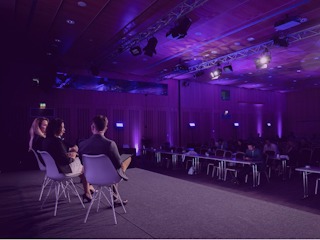March 05, 2024
The saying “innovate or die” might be a cliché, but companies that don’t change and evolve will invariably suffer. Of course, trying new things can be difficult or even scary, especially if your organization punishes failure. What’s needed is a mindset change — one that embraces calculated risks and gives employees permission to learn through failure.
This change starts by rethinking innovation as a series of small experiments in the pursuit of big gains. To instill this in your culture, leaders need to understand the problems they face, how to break those problems down and how to help employees be excited about experimentation rather than fearful.
Identifying the right problems to solve
It’s essential for organizations to identify and address the right problems before diving into solutions. Encourage teams to get beneath the surface and understand why these problems exist — and what your solutions would accomplish.
Successful experimentation invariably requires data to identify specific problems and inform effective decision-making.
When talking about digital transformation, people often really mean decision science. What data do they already have? Or what data do they need to gather to improve the problems they’re seeing in the organization daily?
Look for low-risk tests
Big problems can feel insurmountable, which makes innovation difficult to imagine, much less fun. Break complex problems into smaller tasks, or experiments, so your employees can home in on specific aspects and test foundational hypotheses.
Teams can quickly course-correct before they get too far afield. This is a significance of iteration with agile frameworks, as quick iterations reduce the impact of failure and allow for continuous improvement.
Josh Linkner, the New York Times best-selling author of “Big Little Breakthroughs,” recommends keeping what he calls a “to test” list next to your “to do” list.
“Anytime some idea pops in your head, big, small, ugly, weird, crazy … it doesn't matter. Stick it on the list. It doesn't hurt. It doesn't cost any money. And just the mere existence of the list will boost your creative output, because now it's front and center. You're thinking about it all the time.”
This technique becomes especially powerful once you open it up to your team, he says. “Let everybody add to the “to test” list at the weekly staff meeting. It will absolutely drive business commercial value and it will drive intrinsic human value.”
Engaging employees and fostering collaboration
Employees need a signal that it’s OK for them to take reasonable risks and even fail. Without that support, they’ll avoid experimenting because it doesn’t feel safe and familiar. Leaders can model this behavior with open communication and transparency. When they discuss their experiences with trying new things (and occasionally failing), employees feel like they have permission to propose ideas and take ownership of the results.
As teams become more comfortable taking chances, silos break down, and people begin collaborating across functions. Suddenly, that culture of experimentation enters into view.
Karim Nehdi, CEO of Herrmann International, the creator of the Whole Brain® Thinking model and HBDI® assessments based on it, emphasizes that building a culture of experimentation requires creating psychological safety, which doesn’t happen overnight.
"Psychological safety is the result of many small interactions in which a leader has shown an openness to viewing a situation from somebody else's perspective, of not immediately judging something as right or wrong, but with an openness to experimentation or an openness to a person solving the problem through their own lens and learning something."
Gamifying experimentation and innovation
An authentic and playful environment can further encourage employees to explore new ideas and take risks. Gamification is one way for organizations to make experimentation more enjoyable, motivating and rewarding.
Hackathons and innovation challenges can help to gamify experimentation. These events provide a structured platform for employees to come together and work on creative projects or solve specific problems. While gamification can be fun, make sure it ties back to project and company goals.










